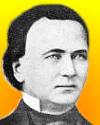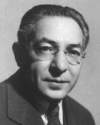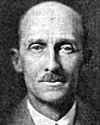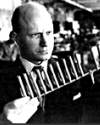
On 29 Jul 1796 Walter Hunt was born, who designed the first repeating rifle. Hunt began inventing in his late teens with a machine to spin flax, which he patented in 1826. He also invented a fire engine gong (1827), a forest saw, paper collars, and a stove that burned hard coals. In 1834, he invented a sewing machine with a lock stitch, which he failed to patent until it was too late. Although his inventions were worthwhile, he failed to market them effectively.
One frequently reads nowadays about patent disputes as inventors jealously protect what they believe to be their original ideas (as for example Apple against Samsung). In reading about historic inventions, for the time and expense invested in patent litigation, one finds famous names have been established, and others have died in poverty.
In the article, Who Invented Sewing-Machines from The Galaxy Magazine (1867) you can read how in times past, debates over an inventor’s priority claim and patent disputes were public knowledge, then as now. In fact, the hapless inventor, Walter Hunt, contrary to this article author’s enthusiasm, is only a footnote in the history of the invention of the practical sewing machine. Hunt failed to refine his idea into a fully reliable, widely marketed form.
We don't even remember him for his “dress pin” invention that is so widely used today. He sold the patent rights for $400. That's all he profited from this long-lasting innovation. This article provides an interesting background about Walter Hunt.

On 29 Jul 1994, Dorothy Crowfoot Hodgkin died, an English biochemist and X-ray crystallographer, who was awarded the Nobel Prize for Chemistry in 1964 for her discoveries. Using X-ray techniques, she discovered the structure of biologically important molecules, including penicillin (1946), vitamin B-12 (1956), and later, the protein hormone insulin (1969). Her achievements included not only these structure determinations and the scientific insight they provided but also the development of methods that made such structure determinations possible.
Today's book pick is: Dorothy Hodgkin: A Life (P), by Georgina Ferry, who paints a portrait of an accomplished woman who combined an ambitious career with family responsibilities, often at great cost. While the context of this book is the development of crystallography, during the initial three decades of its application to organic structures, the focus of the book is simply Dorothy herself the person how she started life, how she worked her way into a scientific career, battled against the odds that were stacked against women in those days, quietly established herself among the top echelon of structural crystallographers and eventually developed an international reputation and influence. Her crystallography was outstanding (it was Dorothy's first and most passionate love) and this book records a fitting tribute to an outstanding and memorable person.
It is available from Amazon, typically about New from $40.00. Used from $6.50. (As of earlier time of writing - subject to change.)
 | I was captured for life by chemistry and by crystals. |
 | My ideal man is Benjamin Franklin—the figure in American history most worthy of emulation ... Franklin is my ideal of a whole man. ... Where are the life-size—or even pint-size—Benjamin Franklins of today? |
 | Earth has few secrets from the birds. |
| Before you look at today's web page, see if you can answer some of these questions about the events that happened on this day. Some of the names are very familiar. Others will likely stump you. Tickle your curiosity with these questions, then check your answers on today's web page. | |
| Births | |
 | Baron Marcel Bich, born 29 Jul 1914, was a French inventor who built his business empire by creating throwaway items. What was his first invention? |
 | Walter Hunt, born 29 July 1796, began inventing with a machine to spin flax, and then a fire engine gong, a forest saw, a stove that burned hard coal. His inventions worked, but he just did not have the knack for making money from them. In 1849, Hunt made a familiar item out of a piece of brass wire about eight inches long, coiled at the center and shielded at one end. He patented his invention as a “dress pin,” and sold the rights to it for four hundred dollars. What is his dress pin now known as? |
| Deaths | |
 | Dorothy Hodgkin (1910-1994) was awarded the Nobel Prize for Chemistry in 1964 for her discoveries of the structure of biologically important molecules, including penicillin, vitamin B-12, and insulin. What method did she use to determine these structures? |
 | John Alexander Newlands (1837-1898) was a British chemist who first established an order of elements by the atomic weights, and observed a periodicity in the properties. Every eighth element has similar properties. It took another quarter century, and the work of others, such as Mendeleev, for the significance of Newland's “law” to be recognized. What name is used for Newland's law? |
| Events | |
 | On 29 Jul 1927, the first electric respirator was installed at Bellevue hospital in New York for the post war polio epidemic. Phillip Drinker and Louis Agassiz Shaw developed it at Harvard University, at first using two vacuum cleaners. The negative pressure machine surrounds the patient’s body except for the head. It alternates a negative atmospheric pressure with the ambient one, resulting in rhythmic expansion of the chest cage for inhalation. This type of machine is rarely used today. What was the new respirator called? |
 | On 29 Jul of a certain year, the first transcontinental airmail flight relay from New York to San Francisco occurred. This was a dangerous occupation: 31 of the first 40 pilots hired to fly mail were killed in crashes. In which decade did this first transcontinental airmail flight relay take place? |
Fast answers for the previous newsletter for July 28: 35,800 ft • plastic, airtight food storage containers • birds • nuclear fission • hydrochloric acid • 800 miles.
 If you enjoy this newsletter, the website, or wish to offer encouragement or ideas, please send feedback by using your mail reader Reply button.
If you enjoy this newsletter, the website, or wish to offer encouragement or ideas, please send feedback by using your mail reader Reply button. Your click on a Facebook, StumbleUpon, or other social button on the site webpages is also a welcome sign of appreciation. Thank you for using them.
© This newsletter is copyright 2020 by todayinsci.com. Please respect the Webmaster's wishes and do not put copies online of the Newsletter — or any Today in Science History webpage. (If you already have done so, please remove them. Thank you.) Offline use in education is encouraged such as a printout on a bulletin board, or projected for classroom viewing. Online, descriptive links to our pages are welcomed, as these will provide a reader with the most recent revisions, additions and/or corrections of a webpage. For any other copyright questions, please contact the Webmaster by using your mail reader Reply button.
--
If you do not want to receive any more newsletters, Unsubscribe
To update your preferences and to unsubscribe visit this link
Executive Real Estate Business Class
-
"It was like a man with wings. It wasn't like anything you'd see on TV or in a monster movie." ...
About the publisher
Search This Blog
Blog Archive
-
▼
2021
(585)
-
▼
July
(50)
- Newsletter for Saturday 31 July.
- Newsletter for Friday 30 July.
- Power off and play this summer!
- Newsletter for Thursday 29 July.
- Newsletter for Wednesday 28 July.
- Newsletter for Tuesday 27 July.
- Newsletter for Monday 26 July.
- Newsletter for Sunday 25 July.
- Newsletter for Saturday 24 July.
- Newsletter for Friday 23 July.
- Newsletter for Thursday 22 July.
- Newsletter for Wednesday 21 July.
- Newsletter for Tuesday 20 July.
- Newsletter for Monday 19 July.
- The Machines That Built America Premieres Tonight
- Newsletter for Sunday 18 July.
- Newsletter for Saturday 17 July.
- Newsletter for Friday 16 July.
- Newsletter for Thursday 15 July.
- Newsletter for Wednesday 14 July.
- Newsletter for Tuesday 13 July.
- On This Day for July 12 - Geraldine Ferraro design...
- Newsletter for Monday 12 July.
- Inventing ‘The Machines That Built America’
- On This Day for July 11 - Duel between Aaron Burr ...
- Newsletter for Sunday 11 July.
- On This Day for July 10 - Telstar 1 launched, John...
- Newsletter for Saturday 10 July.
- On This Day for July 9 - Catherine the Great assum...
- Newsletter for Friday 9 July.
- New Season! Hope, Through History Podcast
- On This Day for July 8 - Vasco da Gama's first voy...
- Newsletter for Thursday 8 July.
- Ending soon: savings that pop! 🎆
- On This Day for July 7 - Hawaiian Islands annexed ...
- Newsletter for Wednesday 7 July.
- On This Day for July 6 - Anne Frank forced into hi...
- Newsletter for Tuesday 6 July.
- On This Day for July 5 - Israel's Law of Return pa...
- Newsletter for Monday 5 July.
- On This Day for July 4 - Declaration of Independen...
- Newsletter for Sunday 4 July.
- July 4th Sale at the HISTORY Store!
- On This Day for July 3 - Battle of Gettysburg ende...
- Newsletter for Saturday 3 July.
- On This Day for July 2 - Civil Rights Act signed, ...
- Newsletter for Friday 2 July.
- July 4th savings that pop!
- On This Day for July 1 - Dominion of Canada establ...
- Newsletter for Thursday 1 July.
-
▼
July
(50)
-
Blogroll
-
About
HistoryFact










This information is so useful and informative which you have shared here. It is beneficial for beginners to develop their knowledge. It is very gainful information. Thanks for share it. patent attorney sydney
ReplyDelete